A Complete Guide To Kimchi
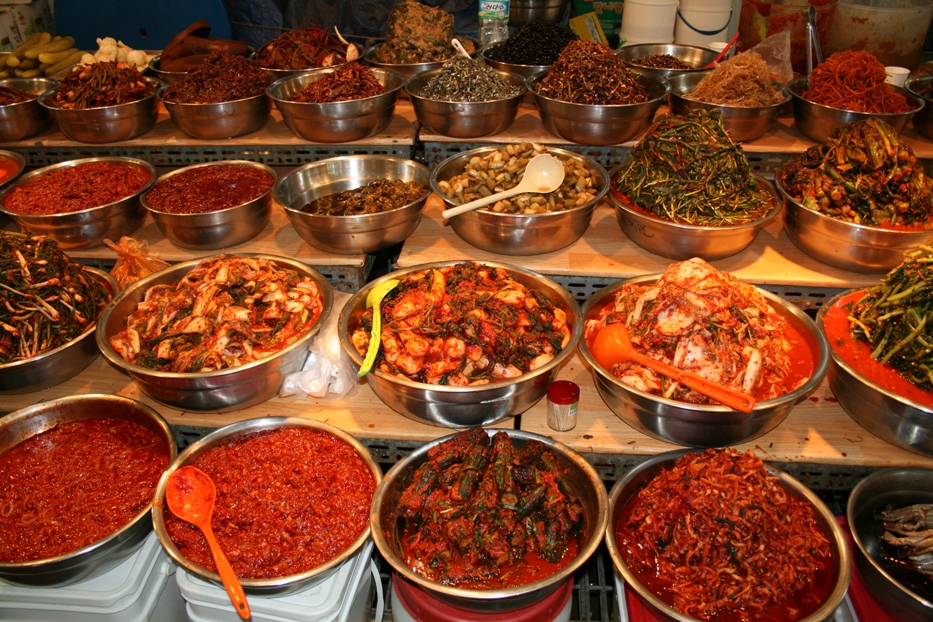
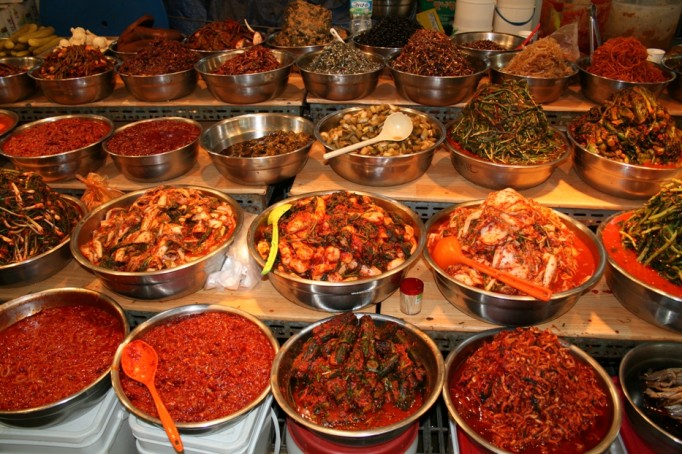
Even if you aren’t familiar with Korean food, you have probably still heard of the traditional Korean dish of Kimchi. But in case you’ve never heard of Kimchi, we’ve got your back! 🙂
Kimchi is a traditional Korean dish and is a major staple in Korean cuisine. Conceived around the 7th century, Kimchi has been rated as one of the most perpetual and healthiest foods in the world. There are many different varieties (we will get into that later) of Kimchi, but the overall texture and taste of Kimchi can be described as crunchy, sweet, tangy, and depending on how much spices are added into the dish itself – it can give your taste buds a serious workout because of how spicy it can truly get 😀 This pickled cabbage classic is usually served as a side dish with breakfast, lunch, and dinner; furthermore, a lot of Korean entree dishes uses Kimchi as a basis as well. Nowadays, Kimchi has become so versatile that around two thirds of Korean people eat Kimchi every single DAY!
The History of Kimchi
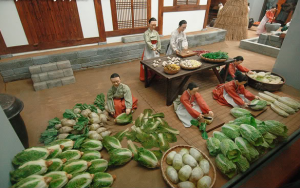 Just like how computer technology changed over time, Kimchi has also been through many different phases of development. LONG time ago (around 918-1392 AD), Kimchi was originally made with only salt and dried cabbages. Different types of garlic and fish paste were then slowly introduced and became the main staple ingredients for the Kimchi basis. During the harsh winters of Korea, the only way people could get their nutrients from the vegetables was to preserve them, or ‘pickle’ them. Once the process of pickling became so common, people were pickling EVERYTHING from bamboo shoots to cucumbers, you name it! But guess what? People started to even ferment soybeans which led to the birth of soy sauce! Isn’t history fun?! From the Koryeo period (918-1392 AD) to the Joseon period (1392 – 1897 AD), and finally to present day Korea, it is amazing to see how the traditional dish of Kimchi has evolved and lived on. During the Koyreo period, Kimchi was a very simple dish. It was simply just sliced radishes and cabbages that was preserved in soy sauce and salt. Fast forwarding to 1592 during the Joseon period, this was the time when Korea went through major culinary changes. Japan at the time had been doing a little trading. They were trading for different starchy foods such as potatoes and corn but one thing that also was on the list was red chile peppers. The Japanese people absolutely fell in love with the potatoes and corn but for some odd reason, they didn’t favor the red chili peppers 🙁 During this trading period, Japan had also been doing a little invasion here and there but also on their hit-list was the mainlands of Korea. As Japan invaded Korea, they took a few ideas from Korea in different categories such as the arts, methods for making pottery, and different ideas behind Buddhism. However, some smart Koreans had also been able to retain some of the ingredients that the Japanese people have left behind during the invasion. The Korean people were able to get their hands on the potatoes, corn and the red chile peppers. With the introduction of the red chile pepper, methods for fermentation had been totally changed where in conclusion also changed the whole appearance and cosmetic looks of the Kimchi. The red color we see in the Kimchi today was because of the introduction of the red chile pepper!
Just like how computer technology changed over time, Kimchi has also been through many different phases of development. LONG time ago (around 918-1392 AD), Kimchi was originally made with only salt and dried cabbages. Different types of garlic and fish paste were then slowly introduced and became the main staple ingredients for the Kimchi basis. During the harsh winters of Korea, the only way people could get their nutrients from the vegetables was to preserve them, or ‘pickle’ them. Once the process of pickling became so common, people were pickling EVERYTHING from bamboo shoots to cucumbers, you name it! But guess what? People started to even ferment soybeans which led to the birth of soy sauce! Isn’t history fun?! From the Koryeo period (918-1392 AD) to the Joseon period (1392 – 1897 AD), and finally to present day Korea, it is amazing to see how the traditional dish of Kimchi has evolved and lived on. During the Koyreo period, Kimchi was a very simple dish. It was simply just sliced radishes and cabbages that was preserved in soy sauce and salt. Fast forwarding to 1592 during the Joseon period, this was the time when Korea went through major culinary changes. Japan at the time had been doing a little trading. They were trading for different starchy foods such as potatoes and corn but one thing that also was on the list was red chile peppers. The Japanese people absolutely fell in love with the potatoes and corn but for some odd reason, they didn’t favor the red chili peppers 🙁 During this trading period, Japan had also been doing a little invasion here and there but also on their hit-list was the mainlands of Korea. As Japan invaded Korea, they took a few ideas from Korea in different categories such as the arts, methods for making pottery, and different ideas behind Buddhism. However, some smart Koreans had also been able to retain some of the ingredients that the Japanese people have left behind during the invasion. The Korean people were able to get their hands on the potatoes, corn and the red chile peppers. With the introduction of the red chile pepper, methods for fermentation had been totally changed where in conclusion also changed the whole appearance and cosmetic looks of the Kimchi. The red color we see in the Kimchi today was because of the introduction of the red chile pepper!
 In modern day Korea, there about 200 different varieties of Kimchi and they all have their unique zangy twist in regards to the flavor. You can see Kimchi even being incorporated into different foods such as hamburgers and pizzas! If you are in Korea, it’s something that you can’t avoid. It’s like saying you will try to avoid salsa when going to Mexico. You can’t. For the unskilled in foreign foods, the first thing that you might notice is how spicy Kimchi can be. If you are given the chance, you will quickly learn on how to accommodate yourself to the spiciness and then will find out how tasty and delicious this traditional dish can be. The taste of the Kimchi is usually a combination of cool, spicy, and tangy. It should also have a crunchy texture and have the crunch sound every time you take a bite into the kimchi, similar to that of when you bite into a piece of carrot. Here’s a little tip on how to tell if you have bad Kimchi or not: “The mushy-ness test.” If the Kimchi is a bit mushy and soft, you know you have a bad Kimchi. It’s not completely bad as you think, but it should usually always have that crunchy texture to it. So in other words, crunchy Kimchi equals a good Kimchi. The different spices, salt, and the right amount of fermentation should give you that superbly balanced and harmonized flavor that characterizes Kimchi.
In modern day Korea, there about 200 different varieties of Kimchi and they all have their unique zangy twist in regards to the flavor. You can see Kimchi even being incorporated into different foods such as hamburgers and pizzas! If you are in Korea, it’s something that you can’t avoid. It’s like saying you will try to avoid salsa when going to Mexico. You can’t. For the unskilled in foreign foods, the first thing that you might notice is how spicy Kimchi can be. If you are given the chance, you will quickly learn on how to accommodate yourself to the spiciness and then will find out how tasty and delicious this traditional dish can be. The taste of the Kimchi is usually a combination of cool, spicy, and tangy. It should also have a crunchy texture and have the crunch sound every time you take a bite into the kimchi, similar to that of when you bite into a piece of carrot. Here’s a little tip on how to tell if you have bad Kimchi or not: “The mushy-ness test.” If the Kimchi is a bit mushy and soft, you know you have a bad Kimchi. It’s not completely bad as you think, but it should usually always have that crunchy texture to it. So in other words, crunchy Kimchi equals a good Kimchi. The different spices, salt, and the right amount of fermentation should give you that superbly balanced and harmonized flavor that characterizes Kimchi.
 As time changes, so do people and the culture just adapts; moreover, culture is tradition and tradition is what no one person or thing can change. The exploitation of foreign cultures cultivates the quality of the global society by bringing people together and sharing different cultures and foods. The popularity of Kimchi in the international arena has become extremely popularized. Kimchi was most popularized during the 1988 Olympics that was held in Seoul, Korea and because of this, the demand for Kimchi has been on the rise ever since. You can even probably find Kimchi at your local Asian super market if you are living in a different country. People have been starting to understand that the different ingredients in Kimchi are superbly healthy for you and have very good nutritional value. In fact, studies have been shown that Kimchi can even help fight off cancer. Since technology has helped the process of making things easier, Kimchi is now mass produced and the increase in sales is going up steadily every year.
As time changes, so do people and the culture just adapts; moreover, culture is tradition and tradition is what no one person or thing can change. The exploitation of foreign cultures cultivates the quality of the global society by bringing people together and sharing different cultures and foods. The popularity of Kimchi in the international arena has become extremely popularized. Kimchi was most popularized during the 1988 Olympics that was held in Seoul, Korea and because of this, the demand for Kimchi has been on the rise ever since. You can even probably find Kimchi at your local Asian super market if you are living in a different country. People have been starting to understand that the different ingredients in Kimchi are superbly healthy for you and have very good nutritional value. In fact, studies have been shown that Kimchi can even help fight off cancer. Since technology has helped the process of making things easier, Kimchi is now mass produced and the increase in sales is going up steadily every year.
Types of Kimchi
As mentioned before, there are about 200 listed varieties of Kimchis in Korea. We won’t touch on them all, but we will dig into 5 of the main types of Kimchis that is usually served in most restaurants. Kimchi is usually categorized into two different categories – seasonal and winter Kimchi. Try and familiarize yourself with these different types of Kimchis and the next time you make a pit stop in a Korean restaurant, try and quiz yourself on asking yourself what type of Kimchi it might be.
“Whole Cabbage Kimchi”
This is the most popular Kimchi out of all on the list. It is typically served with almost all meals from breakfast, lunch, and dinner. This Kimchi is usually never spicy but rather mild. Whole crowns of cabbage are sliced off to abstract any discolored outer leaves and then divided perpendicular into four sections. These four sections are then soaked in salt for about three or four hours until they have eased and softened. While this process of softening is going on, the other ingredients are then assembled and mixed together such as pepper powder, chopped garlic, ginger, and other pickled seafood such as fish. When both the ingredients and the cabbages softening process is finished, they are ready for mixing. Once the process of mixing is finished, the baechu Kimchi is then cut in to bite size pieces and mixed again.
“Chopped Radish Cubes”
Ggakdugi is again one of the more common Kimchis in South Korea. It is made from white radishes (also known as’moo’). These white radishes are then simply cut in to cute little cubes and mixed with the typical ingredients for Kimchi. The Ggakdugi is then topped off with a fine red-pepper chilli powder to give it a very deep red color. Don’t be fooled if it looks spicy because it’s not spicy. This is an excellent choice for beginners as it is generally quite sweet and crunchy.
“Green Water Kimchi”
If you have a meal during the hot and humid Korean summers, you will be thankful for this delicious water Kimchi! Young summer radishes are the main key ingredients for this dish. They are blended with green chili peppers, red chili peppers, and sometimes garlic. A Kimchi sauce is then poured over the mixture and more water is added to the vegetables. When combined with thing white noodles (somyeon), this can be a real summer delight.
“Red Water Kimchi”
Nabak kimchi is a water Kimchi just like the Green Water Kimchi mentioned above. It has very pleasant and graceful appearance created by the cutting of the radish into small bite sized pieces with other colorful ingredients such as cabbage, green onions, and of course red chile peppers. Again, don’t be fooled with the redness of the dish. This dish is a dish usually served mild. The word nabakin regards to the shape of the radish which is a very thing square. It can also be eaten all year around!
“Whole Radish Kimchi / Ponytail Kimchi”
Chonggak Kimchi is a type of Kimchi made of salted and fermented young radishes. The word Chonggak Kimchi came from the name of the young radish, Chonggak-mu, which had the hairstyle of a young boy in the olden days 😀 This Kimchi is for the spicy lovers. The ingredients include garlic, ginger, and spicy red pepper powder. Since this Kimchi is served as a whole radish and doesn’t need too much handling, it contains a plethora of vitamins.
Making Kimchi
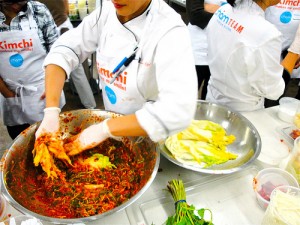 When it comes to making Kimchi, even the general public of Korea has the slightest clue on how to make Kimchi. Even if you have never attempted on making Kimchi, why not start now? Under any circumstances, if you have never done it, the idea itself on making Kimchi may sound intimidating to many people, especially foreigners seeking on trying out new traditional Korean foods. However, do not be appalled by such thoughts! Making Kimchi is actually an easy process if done with a little practice 😉 The process of making Kimchi has remained fundamentally same since its original techniques back when it was first being made. The main key point you have to keep in mind when making Kimchi is the fermentation process of the vegetables. The right amount of ratio between the different ingredients is what makes the perfect Kimchi. For example, if you do not have enough salt to begin with, science tells you that your vegetables will break down and rot; on the other hand, too much salt can kill the bacteria and the Kimchi will not ferment correctly.
When it comes to making Kimchi, even the general public of Korea has the slightest clue on how to make Kimchi. Even if you have never attempted on making Kimchi, why not start now? Under any circumstances, if you have never done it, the idea itself on making Kimchi may sound intimidating to many people, especially foreigners seeking on trying out new traditional Korean foods. However, do not be appalled by such thoughts! Making Kimchi is actually an easy process if done with a little practice 😉 The process of making Kimchi has remained fundamentally same since its original techniques back when it was first being made. The main key point you have to keep in mind when making Kimchi is the fermentation process of the vegetables. The right amount of ratio between the different ingredients is what makes the perfect Kimchi. For example, if you do not have enough salt to begin with, science tells you that your vegetables will break down and rot; on the other hand, too much salt can kill the bacteria and the Kimchi will not ferment correctly.
The easiest and most basic way to make your Kimchi is to start off by cutting your vegetables, usually the Chinese cabbage, Napa cabbage, or radishes will work – into small chunks and soak these babies up in salt-water brine for let’s say… three to five hours depending on the weather. Read carefully to the next part because it’s very important! Then you must thoroughly rinse the cabbage and place it in a bowl. From here, you add red pepper paste, garlic, ginger, any seafood base ingredient (depends on what type of Kimchi you are making), and finally some delicious fish sauce. The mixture is then jarred or put into a bottle left to be fermented at room temperature. The process of making Kimchi takes time. Make sure you leave a couple of days off when making your Kimchi. Making Kimchi can be an excellent family activity or just a great hobby to build upon to. From here, you can expect your Kimchi to sit out for about two days. If you set your Kimchi out longer, the sourness of the Kimchi will be stronger.
*Quick Tip on Things To Look Out For When Making Kimchi*
1.) Mushy Vegetable – As stated above in the history, mushy Kimchi is a bad Kimchi 🙁 Fermenting too long at room temperature can soften the vegetables and cause them to breakdown. You need the right balance between room temperature and cold temperatures.
2.) Mold – This one should be common sense. If you see any mold during the aging process of Kimchi, immediately throw it out.
3.) Taste – If your Kimchi tastes like doo-doo, you know you’re in trouble. The Kimchi most likely has bacteria growing on the Kimchi and can be very harmful if consumed!
Want To Know More About Kimchi?!
Kimchi has become so important in Korean culture that a museum dedicated to just Kimchi has been built. The Kimchi museum founded in 1986 displays historical antiques related anything to Kimchi. Many types of Kimchi, even Kimchi-making process mock ups are presented at the Kimchi Museum. If you are interested, you should seriously check out the Pulmuone Kimchi Museum in Seoul located in the COEX mall.
Address:
Seoul-si, Gangnam-gu, Samseong-dong, 159 COEX MALL B2
Operating Hours:
10:00 – 18:00
Tell us your thoughts about Kimchi. Does it sound appetizing? Does your country serve Kimchi?! Let us know by writing your comments below!

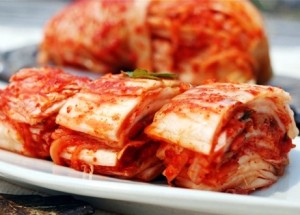
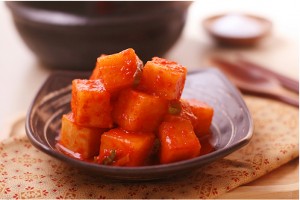
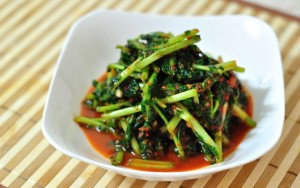
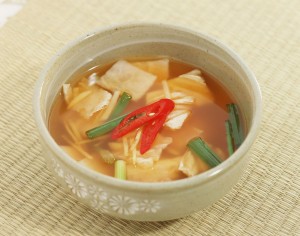
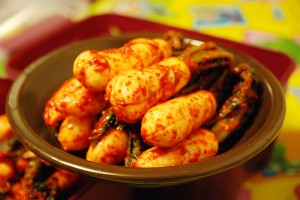
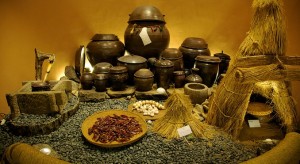




72 Comments
Man, i miss kimchi! It was delicious!!
Your comment…I knew there was over a hundred diffrent kinds of Kimchi but two hundred thats alot.
The kimchi museum in COEX is a little hard to find, actually really hard, it’s also not that interesting, you get more info from this article actually, good work guys! BUT if you make it to the end, there’s many types of kimchi for taste testing, for free! So it’s worth the go, though it does have an admission fee which I don’t remember the price but I think it was 7,000 won since I remember my friend giving me 2,000 won.
Interesting piece. I am very lucky to have Korean supermarkets in my neighbourhood, they sell Kimchi and I always buy it from there, makes a nice lunch to take to university with me.
the most i like in korean foods is kimchi !!! kimchi really delicious ,but i have never try the original made korea. hope i will have the chance 🙂
Where to eat good bbq pork/clams in Seoul? any thing near Incheon (chinatown)?
ngon
I started making kimchi about 3 months ago because I liked the taste of it when I tried it at a Korean restaurant but also because of its health benefits. Now my wife really enjoys it too and can’t wait for the next batch to be ready. We do not have kimchi in Poland but we do have something similar which is fermented white cabbage. But I definitely prefer Korean kimchi to typical sauerkraut we are familiar with in Eastern Europe. I love making a dish with such a long tradition and so many health benefits as well as absolutely delicious taste. I’m grateful to the Korean people for this important contribution to cuisine and I hope more people in Europe will learn how to make and enjoy kimchi. Thank you Korea!
My Korean Aunt introduced me to Korean cuisine at 7yrs old Though i M White I LOVE kim chee and learned how to make it glad to know there are many varieties.
I love love love Korean food. Kimchi is the best although I have only had the napa cabbage variety. I haven’t been brave enough to make it yet.
Thanks for this site. It is really insightful
Stuck on time, ideas, or simply got more important stuff to do? Got that date waiting for you? Grumpy professor won’t let you be?
One of the most popular and well-known types of Dim Sum is considered to be Har Gau or simply dumplings with shrimp. Their peculiarity is not only in the filling-shrimps mixed with raw pork fat, but also in the dough itself, which is made from wheat starch.
Cool article, thanks to author for it! Also he like https://teeest.com for gently.
Gimchi is a Korean food made of spicy seasoned pickled vegetables, primarily Chinese cabbage. In general, these are pickled cabbages or cruciferous leaves seasoned with red pepper, green onions and onion juice, garlic and ginger. Most often it is Chinese cabbage, sometimes with radish slices, but sometimes kohlrabi leaves, radishes, lobs, as well as cucumbers, eggplants and other vegetables are used instead. In Korea, kimchi is considered the main dish. Koreans believe that daily consumption of kimchi contributes to the absorption of fatty deposits, that is, they consider this a dietary dish. I learned this information from YouTube videos in which chefs talk about the cuisines of different nations of the world. I found a lot of videos on this topic there and noticed that most of these videos had about 28 thousand views! I’m sure this is because their authors used the services of https://soclikes.com/ in order to wind up views for YouTube.
Great post! Thank you
Thank you for this article! It is a good topic to make video about. I used to post all my video on tiktok after I read this post https://www.e-architect.com/articles/tiktok-likes and know how to get likes for my video
I love kimchi so much. I don’t know the way to make it. But i’ve seen your post. Thank for sharing.
Information article, it was very helpful! I simply began in this and I’m attractive more familiar with it better! Thanks, keep doing amazing..
Nice Article, I heard many names of Korean foods, but this one is unique for me. Thank you for sharing information about Kimchi Food.
Good article, At The Writer Hub, We also write these type of article.
Kimchi is what my girlfriend and I miss much since we’ve been to Korea before CV19 closed all reasonable ways to travel. Counting days to the moment we can travel again.
very nice and help full post
send cakes to Pakistan
Thanks for sharing this, looking forward to Send Birthday Gifts to Pakistan
The procedure of creation Kimchi has continued basically same meanwhile its unique methods back when it was first existence complete. The chief key point you consume to keep in mind when creation Kimchi is the fermentation procedure of the potatoes.
Your post is very good. I got to learn a lot from your post. Thank you for sharing your article for us. it is amazing post.
custom football jerseys builder
Do you have little time to devote to your education since you are a working student? Or perhaps you require some assistance from pros in online classes? Online Class Help Pro is ready to assist you with any academic problem you may be experiencing. Online courses can easily overwhelm a student with excessive coursework and quizzes.
Is OxEssays scam reviews true? Fortunately, I now know the answer to this question. Therefore, you should visit this site https://essaywritingservices.review/reviews/oxessays-review too. It will be useful for you.
I didn’t have any expectations concerning that title, but the more I was astonished. The author did a great job. I spent a few minutes reading and checking the facts. Everything is very clear and understandable. I like posts that fill in your knowledge gaps. This one is of the sort.
Live your life by a compass, not a clock.
best travel agency for dubai
Yeah its yummm!! korean food 🙂 i love it. i would like to say the complete guidance regarding the recipes i found first time in life . Please keep sharing more like this with me.
shearling coats and jackets